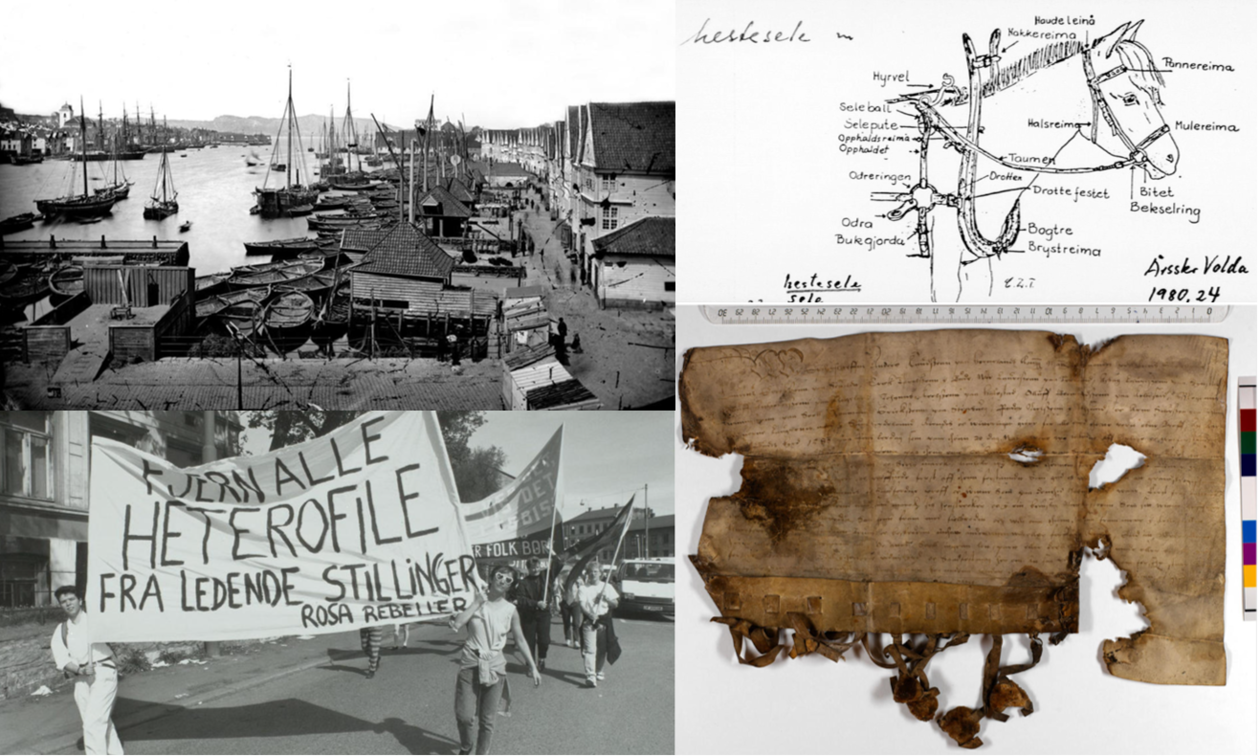Collections and Exhibitions
Making the University Library's collections digitally available and profiling the various collections, as well as providing digital presentation of physical exhibitions.
Main content
The special collections contain unique material with historical photographs, antiquarian documents, queer stories, a Nynorsk word bank and much more. In order to make this material available to the public, we are working on the development of a common digital platform for the collections: Marcus.
The university library's material forms the basis for a number of exhibitions. At the Arts and Humanities Library, we have dedicated exhibition areas that visitors meet right after entering the foyer. But in order to reach as many people as possible and to make such exhibitions long-lasting, the group 'Digital Development' works with the digital part of such exhibitions.
Special Collections
The collections are a treasure trove for research, dissemination and thesis writing. The special collections consist of the Manuscript and Library Collection, the Picture Collection, the Language Collection and the Queer Archive.
The Manuscript and Rare Book Collection
The collection is curating a wide spectrum of material: diplomas, fragments of medieval manuscripts, maps, charts, letters, photographs, rare and large antiquarian book collections, and collections of manuscripts, e.g. the archives of the Nordland’s trade; the guild-archives of Bergen; the bulk of the archive of the founder of the museum, W.F.K. Christie. Get more information on the on the resource page of the Manuscript and Rare Book Collection.
The Picture Collections
The collection is one of the largest and best recognized archives of historic photographs in Norway. With around half a million photographic images, it consists of singular images and collections of various sizes originating with photographers, collectors and private donors. The collection includes well-known Norwegian and Bergen motifs, private albums dating back to the 1860s, documentation from research archives and examples of early photographic techniques. More than 50,000 of the 1.2 million images are available to the public at marcus.uib.no. Get more information on the portal of Marcus.
The Language Collections
The collections are a significant scientific resource consisting of older physical and electronic material. The collections are the basis for the Norwegian dictionaries, and are used in nomenclature studies. In 2016, the language collections were transferred to UiB from the University of Oslo. Get more information on the information page 'Norsk kulturarv i skrift og tale'.
The Queer Archive
The Archive collects, preserves and disseminates Norwegian queer history. One of the pillars of the work is Karen-Christine Friele's personal archive, as well as several collections from other private individuals and organisations. In addition, the Queer Archive is building up a collection of video interviews, and has its own encyclopedia, Skeivopedia, which can be found on the archive's website. Get more information on skeivtarkiv.no/en.
The exhibitions created by Digital Development
Nansen og bergenserne
The exhibition Nansen og bergenserne (2021) is a collaborative project between the University of Bergen Library and the Bjerknes Center for Climate Research; and is part of the celebration of the University of Bergen's 75th anniversary. The digital exhibition "Nansen og bergenserne" includes a Sanity Studio editor and a Next.js frontend.
The digital exhibition is a collaboration between the University of Bergen Library and the project The Nansen Legacy.
Decriminalising History
The exhibition will consist of six parts, each with a separate theme (including law and health). It will bring together material from the Queer Archive, the Picture Collections, the Language Collections and the Manuscript and Rare Book Library Collection to create a queer reading of both the past and the present. The exhibition will have both a physical and digital expression.
The exhibition highlights rights and struggles that still affect us. It should be both a celebration of diversity and a declaration of queer independence. The digital exhibition "Decriminalizing History" includes a Sanity Studio editor and a Next.js frontend.
More than the humanitarian gaze. Jørgen Grinde’s photography from the Middle East in the 1950s
The exhibition shows a selection of Grinde's (1915-1991) photographs of Palestinian refugees in the 1950s, taken from the UN collection belonging to the Picture Collection at the University Library, UiB. The humanitarian eye is often present in photographs of situations where refugees receive help, and women and children are central subjects.
The exhibition, online exhibition and accompanying catalog are the result of a collaboration between Chr. Michelsens Institute (CMI) and the University of Bergen Library, and is supported by Fritt Ord, the Norwegian Center for Humanitarian Studies and by the NFR-funded research project SuperCamp: Genealogies of Humanitarian Containment in the Middle East (CMI).
The digital exhibition "More than the humanitarian gaze. Jørgen Grinde's photographs from the Middle East in the 1950s" includes a Sanity Studio editor and a Next.js frontend.

